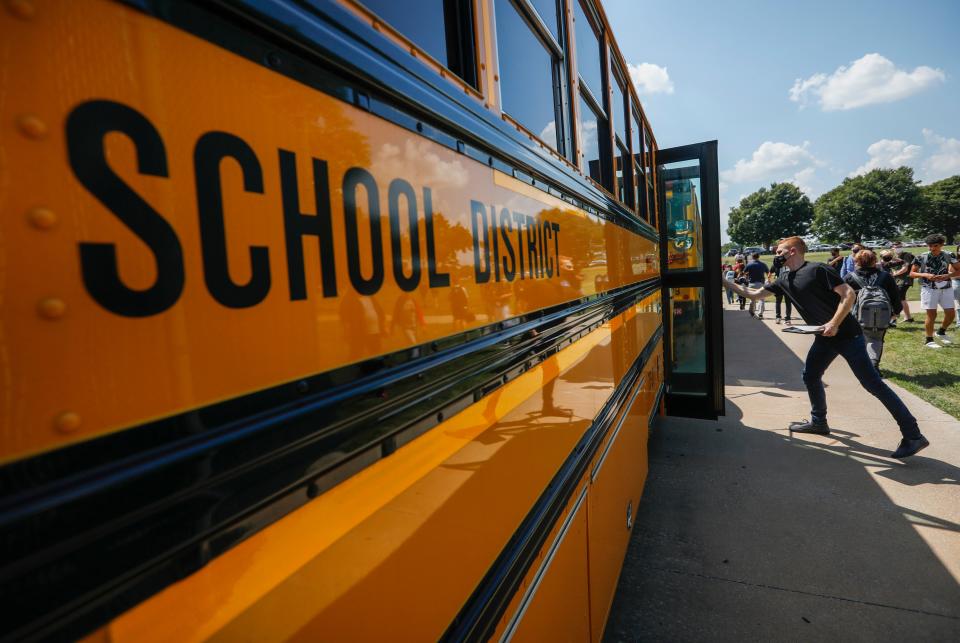With extra help in place, homeless student count in SPS drops by half
Twice in the past five years, the number of students receiving homeless services in Springfield Public Schools soared above 2,000. The highest year was 2,283.
This year, the count stands at 1,005. It was 1,199 for all of the 2021-22 year.
Top officials in Missouri's largest district said they have stepped up efforts to identify and help these students, who are are at the highest risk of falling behind academically and not graduating on time, if at all.
"They're coming from trauma that is substantial. They're housing insecure, which sometimes leads to food insecurity and just the daily comforts that a lot of our kids take for granted, they don't have," said Bret Range, the executive director of student and school services.
"It is our job to create a school that is welcoming for them, that is their safe place."
District officials have streamlined how families access resources and more than doubled the social workers assigned to this population, from just two a few years ago to five now. They said the extra help appears to be paying off in two ways.
First, families that lack secure housing — and often face related challenges including lack of adequate food, clothing and health care — are getting help in a more timely manner. By accessing resources in the district and community, many are achieving greater stability in a shorter amount of time.
Second, social workers who interact regularly with families allows the district to more quickly update the count and accurately reflect families' living situations.
In the past, with fewer staff involved, students eligible for homeless services remained on the list — rolling over from one year to the next — unless a change in status was reported. There was an effort each fall to update the list, which could be time-consuming.
"We have more people to help identify students that are truly eligible for McKinney-Vento status," Range said, referring to the definition used to determine eligibility. "We have cleaned up our processes and are doing a better job."
Pandemic made it harder to identify, help students
The federal McKinney-Vento Homeless Assistance Act, passed in 1987, requires school districts to provide additional help to students who lacks a "fixed, regular and adequate nighttime residence."
There is a portion of students who live in emergency shelters or sleep in cars, parks or abandoned buildings. Some live in pay-by-the-week motels, mostly along Glenstone Avenue, Norton Road and Kearney Street.
However, the overwhelming majority of eligible students are "doubled up," meaning they are couch-surfing or have moved in with an individual or family on a temporary basis after losing permanent housing. The loss may be due to fire, the end of a relationship, or an eviction after a job loss or job change.
Identifying these students is critical because they are eligible, under federal law, for a wide range of services and protections, including:
Immediately enrollment even if they lack the necessary paperwork;
Free school meals;
Free busing;
Remaining enrolled in their "home" or original school, even if the family moves to another attendance area in the district;
Access to health, counseling and other services offered at school.
The homeless count in SPS has dropped but remains substantial, roughly one out of every 24 students.
The district budget for homeless services is currently $550,000 and includes $400,000 in federal funding plus $150,000 in grant funds, which the district applies for annually. A portion of that is for staffing.
It will receive an additional $371,887 this year through the federal American Rescue Plan (ARP) Act of 2021.
The funds can be used to identify homeless students, provide wraparound services following the pandemic and to help eligible students attend school or participate fully in school activities.
"These funds are specifically set aside for homeless students that also want to participate in before and after school care and their families need them to do so because they're either looking for work or currently are working and just need childcare," Range said.
More:Hillcrest celebrates end of renovation, high school hailed as 'heartbeat' of northside
Range acknowledged the pandemic created challenges to serving students eligible for homeless services, especially when the district switched to virtual and hybrid learning schedules. He said keeping tabs on students and meeting their needs is easier when there is "daily contact."
"It did make it more difficult to really target students' needs because we just didn't see them as much but that is getting better," Range said. "This year has been much easier than it was last year and even the year before."
'Transportation is always going to be an issue'
Each year, the district provides scores of referrals to community partners, from Community Partnership of the Ozarks to Care to Learn, to help families with housing insecurity and other challenges. They also have access to food and clothing banks.
Range said students often need referrals for medical, dental and mental health supports, and a constant need is for transportation.

"Transportation is always going to be an issue. That is a huge barrier for these families," he said. The district helps by providing school busing or passes for taxis or city buses.
Courtney Martin, director of student services and homeless coordinator for the district, said the federal grant that was received this year will help the students more actively engage in school.

"They can be part of an activity. They can be part of a group." Martin said. "It gives them the ability to be a kid and not have to worry about the things that they deal with on a regular basis."
The grant funds can be used in the following ways:
Tutoring or other educational services;
Wraparound services, often programs before and after the school day;
Transportation to school and school activities;
Prepaid cards to purchase critical supplies;
Short-term and temporary housing when emergency housing is the only option;
Training for teachers and staff who work regularly with homeless students;
Referrals to medical, dental, mental and other health services.
Martin said while most students eligible for homeless services are "doubled up," not all have a roof over their head on a regular basis.
"There are some unsheltered, which are the really concerning ones," he said.
More:Student lunch debt soars in Springfield Public Schools after pandemic relief program ends
He said employing five social workers, each one assigned to a high school feeder pattern, is making a difference and will help the district more quickly connect families with resources.
In addition to working directly with families, the social workers are present in staff meetings and touch base regularly with teachers and school counselors and nurses. He said they also alert the social workers of students who are not yet receiving homeless services or have a specific, unmet need.
He said: "We have been able to stay on top of it because of communication and through relationship-building."
Springfield student homeless count
The Missouri Department of Elementary and Secondary Education requires districts to report how many students qualify for services under the federal McKinney-Vento Homeless Assistance Act. Here are the numbers reported to the state:
2019-20 − 2,014
2018-19 − 1,790
2017-18 − 2,283
2016-17 − 1,739
2015-16 − 1.420
2014-15 − 1,297
2013-14 − 978
Claudette Riley covers education for the News-Leader. Email tips and story ideas to criley@news-leader.com.
This article originally appeared on Springfield News-Leader: After spike, number of homeless students in SPS drops by half

